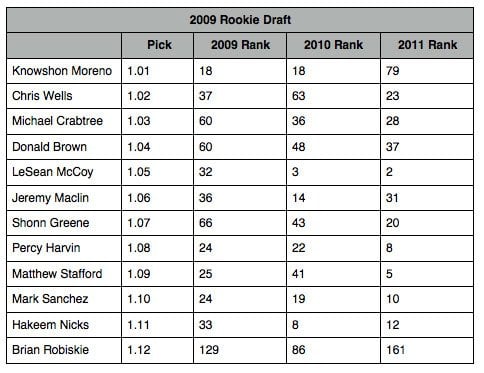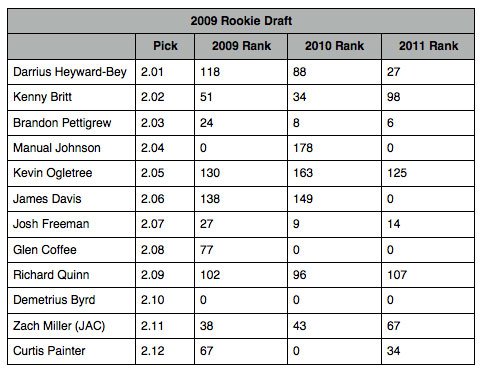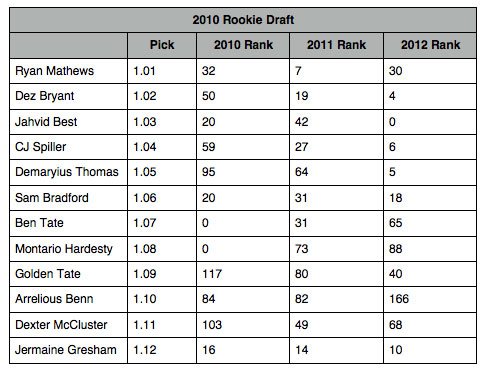Rookie Fever
This is the time of year when dynasty addicts look forward to rookie drafts. The NFL Combine is in the books, pro days for the best prospects are underway and the NFL Draft is just around the corner. It’s also the time when rookie picks gain value. But just how valuable are these rookie picks? Every year, dynasty owners get rookie fever, and it seems to be highly contagious. How can we prove rookie picks are worth the obsession, especially this time of year?
MyFantasyLeague.com (MFL) has an excellent database of rookie drafts spanning several years. I focused on rookie drafts from 2009, 2010 and 2011, as that gave us three years worth of data post-draft to draw some conclusions about dynasty production. The 2009 MFL database featured results of 151 rookie drafts, while 2010 and 2011 databases featured 205 and 244 rookie drafts. While individual leagues may vary, the MFL database represents the best representation for trends in rookie drafts and that’s why we used it for this article.
Let’s take a look at the first round of the 2009 rookie draft from MFL. I used a 12 team, PPR scoring league format:

At first glance, there are some recognizable names on this list. LeSean McCoy is the only elite player on this list and Matt Stafford is a top ten dynasty asset at quarterback. Michael Crabtree and Percy Harvin are talented, but have a lengthy injury history. Half the players on this list have either been busts or failed to meet expectations (Knowshon Moreno, Chris Wells, Donald Brown, Shonn Greene, Mark Sanchez and Brian Robiskie). There were only seven top 12 finishes in three years (19%), and 16 total top 24 finishes (44%). In a 12 team league, only 19% of players drafted finished as a WR1, RB1 or QB1. Inexplicably, Sanchez finished with two top 24 finishes, and a top 12 season, yet he finds himself an NFL backup now.
Now, let’s take a look at round two of the 2009 rookie draft:

There isn’t a single player from round two of the 2009 rookie draft who can be started for fantasy teams. Kenny Britt is the closest and his career has been marked by suspensions, arrests and failed expectations. There were just three top 12 finishes between 2009 to 2011 (8%), and just five total top 24 finishes in three years (13%). Brandon Pettigrew may be the best option for 2014 players and he is at best a TE2 now. There’s not much to like in round 2 of this draft.
Let’s see how the first round of the 2010 rookie draft turned out:
 The 2010 rookie draft has two elite players (Dez Bryant and Demaryius Thomas). Players like CJ Spiller, Golden Tate and Ben Tate still have a shot to break out, while Ryan Mathews is a serviceable RB2, but may not reach his lofty draft status as a 1.01 pick. Jahvid Best had one decent season, but his career met an unfortunate end, while Sam Bradford and Jermaine Gresham have been a QB2 and TE2. Best, Montario Hardesty, Arrelious Benn and Dexter McCluster have been busts, though McCluster has some hope. There were just six total top 12 finishes in this group (2010-2012), or just 16%. There were 11 top 24 finishes, or 30%.
The 2010 rookie draft has two elite players (Dez Bryant and Demaryius Thomas). Players like CJ Spiller, Golden Tate and Ben Tate still have a shot to break out, while Ryan Mathews is a serviceable RB2, but may not reach his lofty draft status as a 1.01 pick. Jahvid Best had one decent season, but his career met an unfortunate end, while Sam Bradford and Jermaine Gresham have been a QB2 and TE2. Best, Montario Hardesty, Arrelious Benn and Dexter McCluster have been busts, though McCluster has some hope. There were just six total top 12 finishes in this group (2010-2012), or just 16%. There were 11 top 24 finishes, or 30%.
Here is round two of the 2010 rookie draft:

There is one big name that stands out and that’s Rob Gronkowski. Pick 2.12 is incredible value for an elite player and those who took Colt McCoy or Jimmy Clausen ahead of him must be kicking themselves. The top three picks of round two are busts and hopefully Toby Gerhart will finally give his owners a return on investment in 2014. Eric Decker is a legit WR2. Remaining players are either limited by injuries (Emmanuel Sanders), character concerns (Aaron Hernandez) or both (Mike Williams). Right now, at least six can be considered busts (Jonathan Dwyer, Clausen, Brandon LaFell, Tim Tebow, McCoy, James Starks). Five had top 12 finishes (13%), and three of those were from Gronkowski. There were 11 top 24 finishes (30%).
Let’s take a look at the 2011 rookie draft:

Mark Ingram starts off the rookie draft for 2011 and he has been a bust. Fortunately, AJ Green, Julio Jones and Cam Newton are all top ten dynasty assets at their positions. The 2011 rookie draft looks like a boom-or-bust proposition, with mostly players who failed to reach expectations. There were six top 12 (16%) and ten top 24 performances (27%) between 2011 to 2013.
Let’s see how the second round of the 2011 rookie draft looks:

The second round of the 2011 rookie draft offers one elite talent (DeMarco Murray), one with elite potential (Randall Cobb) and a solid WR2 with WR1 upside (Torrey Smith). Ironically, the highest consistently ranked player, Andy Dalton, may be unemployed if he can’t win a playoff game and is generally valued as a QB2 in fantasy despite showing QB1 numbers two of the past three years. It is sobering that only three top 12 finishes were noted from 2011 to 2013 (8%), while seven achieved top 24 numbers (19%).
In summary, here are the top performances from rookie drafts 2009-2011:
 There is much debate about value of rookie picks versus proven veterans. The data from rookie drafts 2009-2011 appear to show significant risk in relying on rookie picks to build a team. In 12 team leagues, using this data set, only 16% to 19% will have a top 12 finish to a season over the following three years, and that means the number of QB1, RB1, WR1 or TE1 seasons from rookies will be significantly limited. These results suggest using picks to acquire veterans with proven production is a more reliable proposition rather than taking chances on rookies. Even top three picks aren’t safe, as just five top 12 performances were noted for picks 1.01, 1.02 and 1.03 from 2009 to 2011 rookie drafts (18%). In looking at round two rookie picks, only 8% to 13% will have a top 12 fantasy season at their positions.
There is much debate about value of rookie picks versus proven veterans. The data from rookie drafts 2009-2011 appear to show significant risk in relying on rookie picks to build a team. In 12 team leagues, using this data set, only 16% to 19% will have a top 12 finish to a season over the following three years, and that means the number of QB1, RB1, WR1 or TE1 seasons from rookies will be significantly limited. These results suggest using picks to acquire veterans with proven production is a more reliable proposition rather than taking chances on rookies. Even top three picks aren’t safe, as just five top 12 performances were noted for picks 1.01, 1.02 and 1.03 from 2009 to 2011 rookie drafts (18%). In looking at round two rookie picks, only 8% to 13% will have a top 12 fantasy season at their positions.
Here is a summary of the top ten values for rounds 1 and 2 of rookie drafts from 2009 to 2011:

In rookie drafts 2009 to 2011, only four tight ends finished in the top 10 rookie picks (13%). Six running backs finished among the top ten (20%). Wide receivers dominated the most productive picks, with 13 finishing in the top 10 (43%). Next in line are quarterbacks with seven (23%).
A total of 25 running backs were drafted 2009-2011, and only six finished in the top ten rookie picks (24%). Wide receivers proved to be a productive position, with 28 drafted and 13 finishing in the top ten rookie picks (46%). Quarterbacks were taken 12 times, and were the most likely to finish in the top 10 with a total of seven (58%). Quarterbacks do have an advantage given their propensity to score more points compared to other positions. While quarterbacks had the highest success rate, only Newton and Stafford can still be considered elite. Tight ends had a solid 57% succeed, but the smallest sample size of 7 picked 2009-2011, and only one can be considered elite now (Gronkowski).
It seems like wide receivers are the safest rookie picks and that’s notable as the 2014 draft looks to be plentiful at the wide receiver position.
My conclusions from this data set are:
- Rookie picks are overrated.
- Don’t be shy about trading rookie picks for more established, productive veterans.
- The most reliable rookie picks are wide receivers.
- The second most drafted position, running back, carries the worst success rate for rookie picks. The 2014 running back draft class is looking less-than-stellar, so beware of taking too many shots on this position. Going running back heavy may not be the most efficient means of building a team. Trading rookie picks for established veterans may be a more efficient solution at running back.
- Dynasty Capsule: Carolina Panthers - February 3, 2017
- The Dynasty Doctor: CJ Anderson - January 25, 2017
- The Dynasty Doctor: Week 15 - December 20, 2016


































































